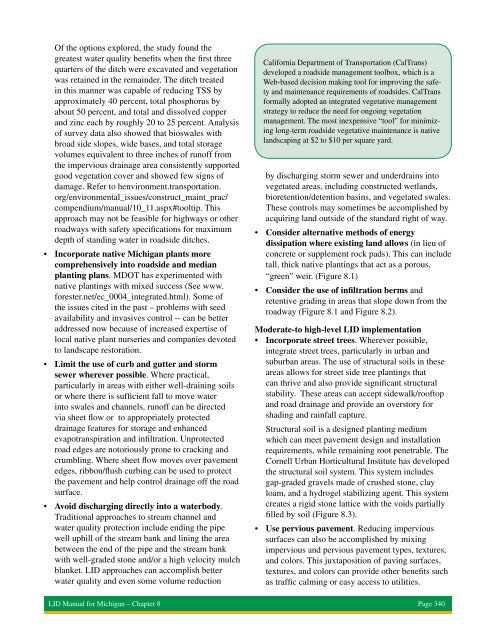Low Impact Development Manual for Michigan - OSEH - University ...
Low Impact Development Manual for Michigan - OSEH - University ...
Low Impact Development Manual for Michigan - OSEH - University ...
You also want an ePaper? Increase the reach of your titles
YUMPU automatically turns print PDFs into web optimized ePapers that Google loves.
Of the options explored, the study found the<br />
greatest water quality benefits when the first three<br />
quarters of the ditch were excavated and vegetation<br />
was retained in the remainder. The ditch treated<br />
in this manner was capable of reducing TSS by<br />
approximately 40 percent, total phosphorus by<br />
about 50 percent, and total and dissolved copper<br />
and zinc each by roughly 20 to 25 percent. Analysis<br />
of survey data also showed that bioswales with<br />
broad side slopes, wide bases, and total storage<br />
volumes equivalent to three inches of runoff from<br />
the impervious drainage area consistently supported<br />
good vegetation cover and showed few signs of<br />
damage. Refer to henvironment.transportation.<br />
org/environmental_issues/construct_maint_prac/<br />
compendium/manual/10_11.aspx#tooltip. This<br />
approach may not be feasible <strong>for</strong> highways or other<br />
roadways with safety specifications <strong>for</strong> maximum<br />
depth of standing water in roadside ditches.<br />
• Incorporate native <strong>Michigan</strong> plants more<br />
comprehensively into roadside and median<br />
planting plans. MDOT has experimented with<br />
native plantings with mixed success (See www.<br />
<strong>for</strong>ester.net/ec_0004_integrated.html). Some of<br />
the issues cited in the past – problems with seed<br />
availability and invasives control -- can be better<br />
addressed now because of increased expertise of<br />
local native plant nurseries and companies devoted<br />
to landscape restoration.<br />
• Limit the use of curb and gutter and storm<br />
sewer wherever possible. Where practical,<br />
particularly in areas with either well-draining soils<br />
or where there is sufficient fall to move water<br />
into swales and channels, runoff can be directed<br />
via sheet flow or to appropriately protected<br />
drainage features <strong>for</strong> storage and enhanced<br />
evapotranspiration and infiltration. Unprotected<br />
road edges are notoriously prone to cracking and<br />
crumbling. Where sheet flow moves over pavement<br />
edges, ribbon/flush curbing can be used to protect<br />
the pavement and help control drainage off the road<br />
surface.<br />
• Avoid discharging directly into a waterbody.<br />
Traditional approaches to stream channel and<br />
water quality protection include ending the pipe<br />
well uphill of the stream bank and lining the area<br />
between the end of the pipe and the stream bank<br />
with well-graded stone and/or a high velocity mulch<br />
blanket. LID approaches can accomplish better<br />
water quality and even some volume reduction<br />
Cali<strong>for</strong>nia Department of Transportation (CalTrans)<br />
developed a roadside management toolbox, which is a<br />
Web-based decision making tool <strong>for</strong> improving the safety<br />
and maintenance requirements of roadsides. CalTrans<br />
<strong>for</strong>mally adopted an integrated vegetative management<br />
strategy to reduce the need <strong>for</strong> ongoing vegetation<br />
management. The most inexpensive “tool” <strong>for</strong> minimizing<br />
long-term roadside vegetative maintenance is native<br />
landscaping at $2 to $10 per square yard.<br />
by discharging storm sewer and underdrains into<br />
vegetated areas, including constructed wetlands,<br />
bioretention/detention basins, and vegetated swales.<br />
These controls may sometimes be accomplished by<br />
acquiring land outside of the standard right of way.<br />
• Consider alternative methods of energy<br />
dissipation where existing land allows (in lieu of<br />
concrete or supplement rock pads). This can include<br />
tall, thick native plantings that act as a porous,<br />
“green” weir. (Figure 8.1)<br />
• Consider the use of infiltration berms and<br />
retentive grading in areas that slope down from the<br />
roadway (Figure 8.1 and Figure 8.2).<br />
Moderate-to high-level LID implementation<br />
• Incorporate street trees. Wherever possible,<br />
integrate street trees, particularly in urban and<br />
suburban areas. The use of structural soils in these<br />
areas allows <strong>for</strong> street side tree plantings that<br />
can thrive and also provide significant structural<br />
stability. These areas can accept sidewalk/rooftop<br />
and road drainage and provide an overstory <strong>for</strong><br />
shading and rainfall capture.<br />
Structural soil is a designed planting medium<br />
which can meet pavement design and installation<br />
requirements, while remaining root penetrable. The<br />
Cornell Urban Horticultural Institute has developed<br />
the structural soil system. This system includes<br />
gap-graded gravels made of crushed stone, clay<br />
loam, and a hydrogel stabilizing agent. This system<br />
creates a rigid stone lattice with the voids partially<br />
filled by soil (Figure 8.3).<br />
• Use pervious pavement. Reducing impervious<br />
surfaces can also be accomplished by mixing<br />
impervious and pervious pavement types, textures,<br />
and colors. This juxtaposition of paving surfaces,<br />
textures, and colors can provide other benefits such<br />
as traffic calming or easy access to utilities.<br />
LID <strong>Manual</strong> <strong>for</strong> <strong>Michigan</strong> – Chapter 8 Page 340

















